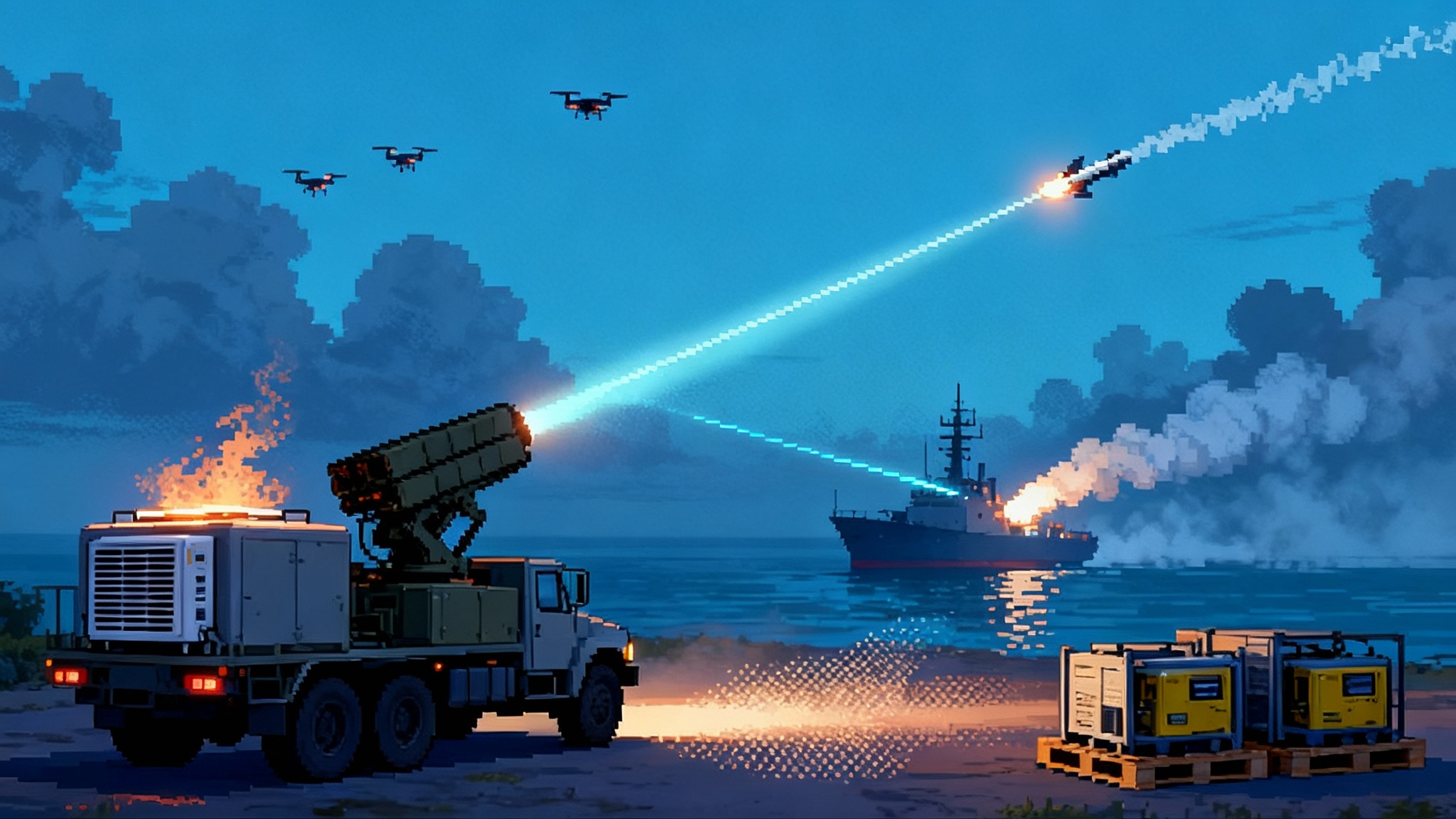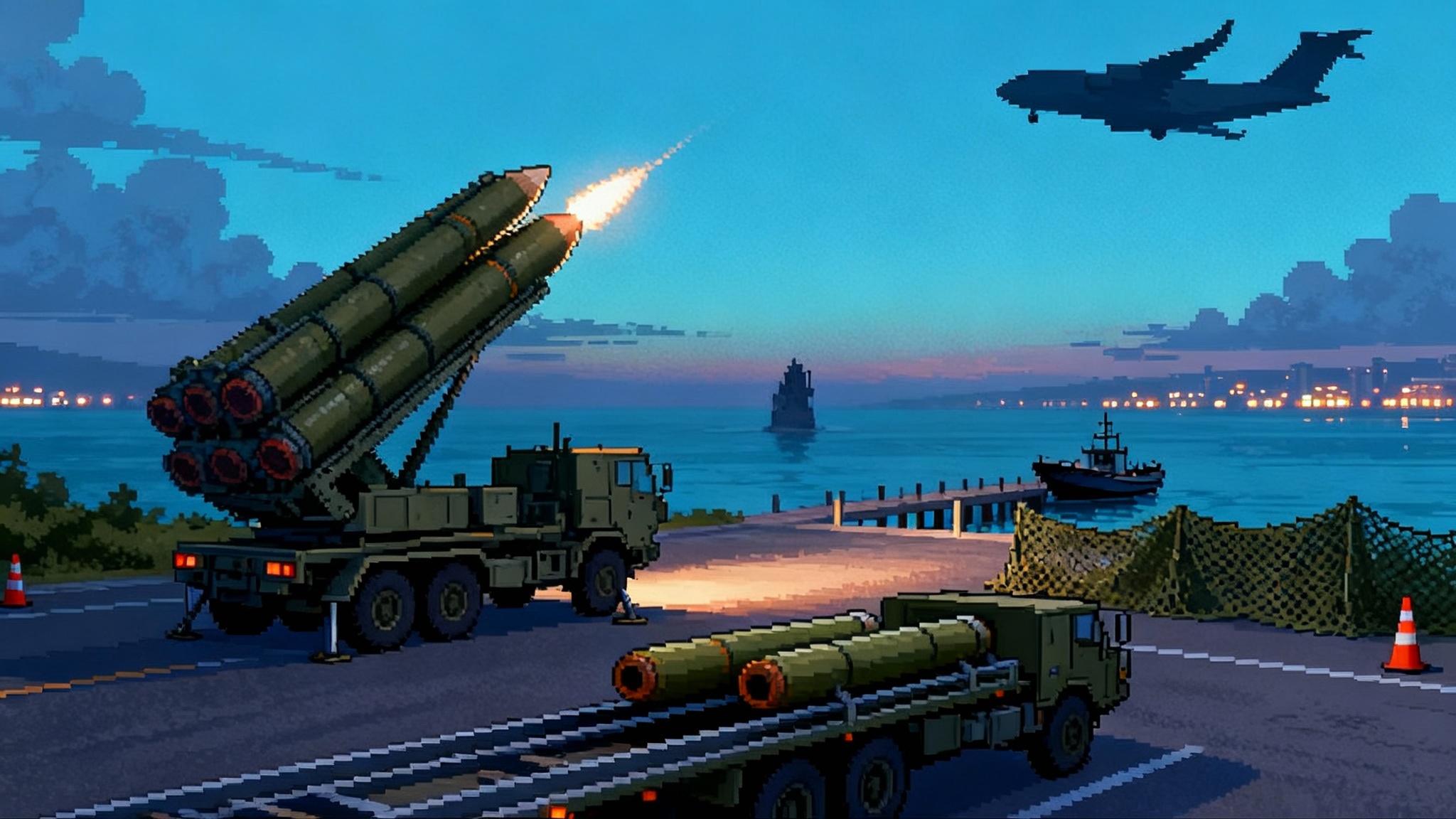Iron Beam’s 2025 debut rewrites air-defense economics
Israel’s Iron Beam high-energy laser enters service in 2025 and flips the cost curve of air defense. Dollar-level shots, deep magazines, and software-driven control meet hard limits from weather, power, and beam quality. Here is what changes next.

The week a beam became a budget line
In 2025 Israel moved its high energy laser, Iron Beam, from test range to operational use. That single shift is more than a headline. It is a new spreadsheet for modern air defense. For two decades, defenders have spent tens of thousands to millions of dollars to shoot down threats that often cost a few hundred dollars to launch. A laser flips that trade. Electricity replaces explosives. Power and cooling replace reload trucks. Software replaces much of the inventory risk.
Think about a garden hose versus a water balloon. Missile interceptors are balloons. Each is a sealed package with a one-time effect. You can throw only as many as you brought. A laser is the hose. As long as your water and pressure hold, you can keep a stream on target.
Iron Beam is the first example of that hose on a crowded street. It does not replace Israel’s kinetic layers. It changes how those layers are used and when they are worth the cost.
Why lasers now, and why this matters
Lasers have teased militaries for decades. The theory was always attractive. A beam moves at the speed of light, ignores gravity, and costs roughly the price of electricity to fire. The problems were also clear. Generating 100 to 300 kilowatts of clean, tightly focused light, holding it on a moving target through turbulent air, and then dumping heat from the weapon and the platform is hard.
Several technology curves have finally intersected:
- Electric lasers got smaller, more efficient, and more rugged. That makes them deployable on trucks and ships.
- Sensors and fire control got faster and cheaper. That enables automated engagements against small, numerous threats.
- The threat changed. Swarming drones and massed rockets create the exact problem that lasers solve best: lots of relatively soft targets that come in waves. This mirrors the push for scale in programs like Replicator’s mass arrives in the Pacific.
Israel’s 2025 fielding of Iron Beam is the first time a country has bet that the curves have crossed enough to matter in combat, not just in demonstrations.
The cost-per-shot math you can do on a napkin
Start with what a laser is actually spending during a shot. A 100 kilowatt beam running for five seconds outputs 500 kilojoules of energy. In household units, that is about 0.14 kilowatt hours. Retail electricity at twenty cents per kilowatt hour would put the raw energy cost of that shot at a few cents. Real systems have inefficiencies. Power conditioning, beam control, thermal management, and maintenance drive the true cost into the single digits to low tens of dollars per engagement. Even if we prudently triple that, you are still in tens of dollars, not thousands.
Now compare that with kinetic interceptors:
- Interceptors for short-range rockets or inexpensive drones often cost tens of thousands of dollars each.
- Medium-range interceptors can cost hundreds of thousands to over a million dollars.
- Long-range interceptors can run several million dollars per shot.
When your opponent is filling the sky with four-figure threats, trading thousand-fold cost disadvantages is not sustainable. That is the equation Iron Beam changes.
Magazine depth is now a power problem, not a logistics problem
Traditional air defense batteries are limited by what is in the canisters and on the trucks that day. Lasers are limited by power generation, beam quality, and the cooling plant. If the generator runs and the radiator breathes, the magazine keeps refilling.
That does not mean infinite fire. Power systems have duty cycles. Thermal systems saturate. Cloud cover and smoke can force longer dwell times, which eats into the sustainment rate. But the nature of the limit is different. A commander can decide to divert more power, throttle other consumers, or add a mobile generator and a chiller to unlock more shots. Longer term, austere sites could benefit from Project Pele’s truckable microreactor to stabilize power.
What lasers do well, and where physics still says no
Every defense technology has a cone of excellence. Lasers excel at burning or shattering relatively fragile surfaces and components on small to medium targets within line of sight.
- Small and medium drones. A few seconds of dwell burns sensors, flight controls, or wings.
- Rockets and mortars. Heating the casing can weaken structural integrity during flight.
- Some cruise missiles. Depending on materials and approach angles, lasers can blind seekers or degrade control surfaces.
Physics still holds hard lines:
- Weather hurts. Fog, rain, dust, smoke, and salt spray scatter and absorb energy. In poor visibility you need more power and more time on target, or you defer to kinetic effectors.
- Beam control is nontrivial. Turbulent air blurs the spot. Adaptive optics and better tracking improve this, but they do not erase it.
- Power and heat are bosses. High power lasers turn electricity into heat as a byproduct. If the cooling loop cannot keep up, the weapon takes a break.
- Armor and mass matter. Heavily shielded or very fast targets reduce laser effectiveness. You still want missiles for high end threats.
The correct mental model is a layered team. Lasers are the low cost pitcher that eats innings against the easy batters. Missiles are the closers for the hitters who can change the game with one swing.
How Iron Beam changes the playbook
Israel built air defense depth out of necessity. Iron Beam adds three new plays to that book.
- It absorbs the bulk of nuisance fire. Short range rockets, quadcopters, and one-way drones are the exact targets that emptied magazines and budgets in recent years. Shifting those to a laser preserves expensive interceptors for the rare, high consequence shots.
- It lowers the bar for continuous protection. When the cost per shot is tens of dollars, commanders can afford to keep the system on and engaging more often, rather than saving interceptors for certain threat profiles.
- It increases psychological resilience. Attackers lose the ability to bleed a defender with cheap salvos. That changes campaign calculus.
Iron Beam is not a silver bullet. It is a cost lever that multiplies what the rest of the network can do.
The remaining constraints, and how to work around them
- Weather and obscurants. Plan for forecast-aware tactics. Pair lasers with radar cued guns and missiles, and preposition smoke and dust monitors. Build a playbook that says when to hand targets to other layers.
- Beam control. Invest in better turbulence sensing and adaptive optics. Use multiple look angles where terrain allows. On ships, improve stabilization and isolation to reduce jitter in heavy seas.
- Power. Treat power and cooling as munitions. Track them on the same dashboard as interceptor inventory. Add mobile power modules and redundant chillers. Train crews to manage duty cycles like fuel.
- Target classification. Automate the easy calls. Humans should approve rules, not every shot. The tempo of drone swarms leaves no time for manual sorting.
What this means for the Red Sea, Ukraine, and the Indo-Pacific
- Red Sea and nearby seas. Warships and bases face volleys of drones and cruise missiles. A 100 to 150 kilowatt laser that can burn or blind seekers at a few kilometers changes the math on harassment attacks. Ships can preserve their vertical launch cells for long range shots and let lasers eat the small stuff when weather cooperates.
- Ukraine. Ground units and cities face frequent drone and rocket harassment. Truck-mounted lasers with deep magazines can cover ammunition depots and bridges, freeing scarce interceptors for ballistic and long range cruise threats. When winter fog rolls in, commanders shift to guns and missiles. The mix is dynamic.
- The Indo-Pacific. Long sealines and distributed bases demand persistence. Lasers on logistics ships and expeditionary bases can shave the top off saturation attempts by drones, freeing Aegis and Patriot batteries for the handful of real killers in a raid. The strategy becomes about sorting by hardness, range, and cost.
Microwave systems complement lasers against dense swarms, as explored in high power counter UAS.
The fast-follow path for 2026 to 2028
Israel has shown the water is warm. U.S. services and allies have three years to make lasers a normal layer rather than a science project. The milestones look practical, not exotic.
- 100 to 150 kilowatt class on ships. Several navies have already integrated first generation lasers on destroyers and amphibious ships. The next step is to field a small fleet set with sustained power and cooling upgrades, trained crews, and tactics that treat lasers as primary against drones and some cruise missiles on clear days.
- 50 to 100 kilowatt class on armored vehicles. Stryker-like platforms already carry 50 kilowatt class weapons. The goal is to make those platoon-level tools with enough power and thermal capacity to run for hours. The pairing is simple: laser for the drone, proximity-fused shell for the mortar, missile for the cruise target.
- 300 kilowatt class fixed and semi-fixed for base defense. The near term use is protecting ports, ammunition depots, and airfields. These sites can host containerized power and cooling and offer clear lines of sight. That geometry fits lasers.
Allies have complementary efforts. The United Kingdom’s DragonFire program has demonstrated precision burns at tactically relevant ranges. Germany has proven naval integration with a lower power demonstrator and aims higher. Japan and South Korea are moving fast on counter drone lasers for base defense. The pressure and the playbook are the same everywhere: push lasers into the spots where they replace the most expensive shots first.
Practical procurement, not a science fair
To move fast without breaking trust, acquisition teams should focus on four concrete actions.
- Standardize interfaces. Publish open power, cooling, and fire control interfaces. A laser should plug into a ship or a truck the way a radar does. The result is competition where it matters and speed where you need it.
- Buy the boring bits early. Generators, chillers, battery buffers, and cable sets have long lead times. They are also common across vendors. Fill warehouses with the generic hardware now, then integrate the laser module as it matures.
- Train to weather. Crews should know the local atmospheric penalty hour by hour. Build weather-informed tactics and drills. The best units will pivot automatically from laser to gun to missile and back as conditions change.
- Instrument everything. Put power draw, thermal load, beam quality, and engagement outcomes on a single dashboard. Leaders should manage lasers the way they manage fuel, ammunition, and maintenance today.
The engineering checklist that will separate winners from talkers
- Power density. Can the platform deliver steady, clean power under motion and heat without constant resets?
- Thermal headroom. How many shots at summer noon before the system needs a pause? What about at night? Crews need real numbers, not brochures.
- Beam quality under turbulence. Does adaptive optics hold the spot tight enough on a small drone at slant range in hot, shimmering air?
- Dwell time automation. Can the system modulate power and dwell based on target class and attitude without human micromanagement?
- Maintenance hour per operating hour. If the weapon needs a spa day after every shift, it will not scale.
Tactics that actually change the fight
- Use lasers to shape the raid. Let the laser cut out the outer ring of a swarm, then hand the survivors to missiles. That reduces the number of hard targets and breaks the coordination of the attack.
- Protect the protectors. Put a laser on a convoy escort to cover the big radar trucks and missile launchers. The laser catches cheap drones and saves missiles for the handful of serious threats.
- Deception and redundancy. Pair lasers with decoy emitters. Draw drones into clean arcs with fewer background clutter and better cooling airflow.
- Night and dawn advantage. Thermal management is easier when ambient is lower. Plan maintenance for afternoons and heavy engagement for the cooler hours when possible.
What to watch in the next 24 months
- Real operational data. How many laser shots per day do crews achieve in mixed weather, and what is the sustained cost per effect once maintenance and manpower are counted?
- Integration on more hulls and trucks. It is one thing to field a handful of prototypes, another to equip a squadron or a brigade. Watch how quickly the support ecosystem grows.
- Rules of engagement and safety doctrine. Lasers introduce new considerations for aviation safety, eye hazards, and reflective surfaces. Procedures and training will mature fast once units use them daily.
- Countermeasures. Expect attackers to try shiny coatings, tumbling drones, and smoky aerosols. The cat and mouse will raise the premium on adaptive optics and higher power.
A sober view on the economics
There is a temptation to declare that lasers make air defense free. They do not. The cost moves. Electricity, generators, cooling, training, maintenance, and spares replace a portion of the missile bill. But the slope is in the defender’s favor. You pay for the plant and the crew, then you pay a small, repeatable cost for each engagement. When the other side tries to bankrupt you with volume, that difference is decisive.
For finance and logistics leaders, the change is profound. You budget for power and maintenance instead of bulk interceptors. You hedge against supply shocks with diesel, gas, or local grids, not with storage depots of solid propellants. You order cables, pumps, and batteries, and you keep a few interceptors for the rare targets that demand them.
The bottom line for commanders
- Put lasers where the target set is soft, numerous, and close.
- Keep missiles for the fast, hard, and rare.
- Treat power and cooling like ammunition. Measure, plan, and rehearse.
- Train weather-aware teams. Make the handoff between layers automatic and calm.
Iron Beam’s arrival in 2025 proves that the laser chapter is no longer speculative. It is operational and it is economic. The fastest movers will not be those with the hottest beam on a slide. They will be the units and navies that treat lasers as part of a living system with power, cooling, software, and smart tactics.
The right kind of revolution
Military revolutions are often more about logistics than lab breakthroughs. Iron Beam’s debut shows that when we change the unit of fire from a missile canister to a kilowatt hour, we change the choices leaders can afford to make. In the Red Sea, in Ukraine, and across the Indo-Pacific, that opens a path to resilient defense that an adversary cannot cheaply exhaust.
The physics stayed the same. The engineering matured. The economics flipped. The next three years will belong to the teams who treat lasers like what they are now becoming in practice: the everyday hose that handles the flood so the few precious balloons can stop the real threats.








